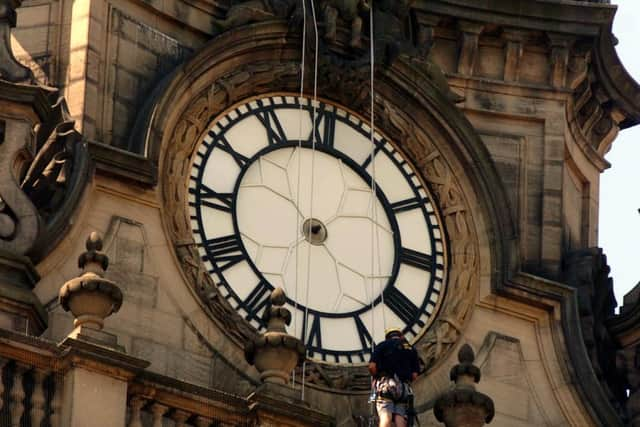A to Z of Leeds: The curious custom of the Town Hall clock


There are many reasons for this bold claim, from the people who've called this place home, to the history of the region, the developments underway and the talent and creativity we see on a daily basis. Here, we go through the alphabet to give you some reasons to be proud.
C IS FOR CLOCK - LEEDS TOWN HALL
A curious custom used to be associated with the Town Hall clock in Leeds and it was this: that when the clock struck 12, have-a-go heroes would try to sprint all the way round the building before the last chime.


Advertisement
Hide AdAdvertisement
Hide AdBut according to a report in the YEP in January 1932, no-one, not even professional athletes, could manage the feat, although one anecdotal account from several years later says one man did it.
The clock was hung on January 3, 1860, two years after its opening attended by Queen Victoria.
The bell tower has 270 stone steps. It was wound mechanically twice a day until it was fitted with electrical winding gear on September 11, 1929.
A report on October 18, 1935 has at one time the chimes could be heard as far away as Pudsey, Oakwood and even Harewood Avenue (11 miles away).
Advertisement
Hide AdAdvertisement
Hide AdThe four-ton 6 ft-tall Victoria Bell was cast at Crescent Works, Cripplegate, London, where Big Ben of Westminster’s bells were made.
The clock has frequently broken down. It stopped in October 1930, January 1934 and September 1940 when its hands were replaced; July 1950 when the hands were stuck at midnight; October 1954 when the clock stopped at 8pm. In September 1969 the clock shut down for a two-week refurbishment and in September 1984 the clock hands whizzed forwards and backwards during repairs.
In March 1941, three of the clock’s opal glass panels were damaged by an air raid, then replaced by tin painted white.
In September 1943, the clock struck from 7am to 10pm for first time since 1939; it fell silent again in 1947 in deference to Infirmary patients.
Advertisement
Hide AdAdvertisement
Hide AdIn April 1945, the clock was illuminated for first time since outbreak of war. And in October 1974, metalworker Richard Coates was winched to safety from the clock tower by an RAF helicopter crew after injuring himself.
MORE A TO Z OF LEEDS:
*********************
A message from the Editor:
Leeds has a fantastic story to tell - and the Yorkshire Evening Post has been rooted firmly at the heart of telling the stories of our city since 1890. We believe in ourselves and hope you believe in us too. We need your support to help ensure we can continue to be at the heart of life in Leeds.
Subscribe to our website and enjoy unlimited access to local news and information online and on our app. With a digital subscription, you can read more than 5 articles, see fewer ads, enjoy faster load times, and get access to exclusive newsletters and content. Click here to subscribe. For more details on our newspaper subscription offers click here.
Thank you
Laura Collins
Comment Guidelines
National World encourages reader discussion on our stories. User feedback, insights and back-and-forth exchanges add a rich layer of context to reporting. Please review our Community Guidelines before commenting.